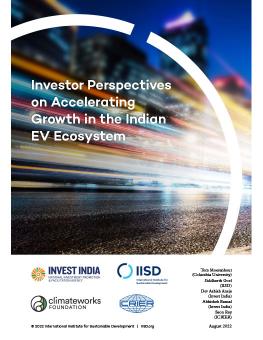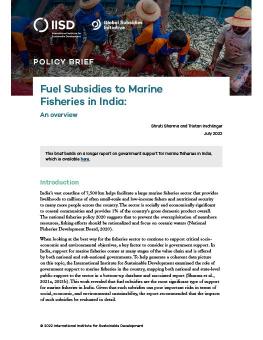Exclusive: India's long awaited green hydrogen policy revealed
With a $2.5 billion (INR ~199 billion) plan to boost hydrogen production and demand in the country, India is betting on the fuel to help achieve its 2070 net zero target.
With a $2.5 billion (INR ~199 billion) plan to boost hydrogen production and demand in the country, India is betting on the fuel to help achieve its 2070 net zero target.
As per a recent report published by the International Institute for Sustainable Development, fossil fuels account for around 76% of India’s total primary energy supply. 18% of the total revenue of the Government is derived from fossil fuels. Against this backdrop, India is set to take a giant leap by the passing of the Energy Conservation (Amendment) Bill, 2022 (Bill) by the Lok Sabha on August 8, 2022.
This webinar presents the findings of a new IISD report that provides an evidence-based approach to ensuring India’s state-owned enterprises (SOEs) are part of the country’s clean energy transition while also continuing to bring revenues to the government, create jobs, and support local communities. The presentation is followed by a panel discussion on opportunities for SOEs in the clean energy future.
SOEs—known in India as Public Sector Undertakings (PSUs)—hold dominant positions in India’s energy sector, controlling coal mining, transport, power generation; natural gas exploration; and crude oil extraction, refining, and marketing. They bring sizable financial returns to the Government of India, employ millions of citizens, engage in community building, and take on activities of strategic importance. With the growing pressure from cost-competitive clean energy sources and India’s global decarbonization commitments, Indian PSUs are expected to face challenges due to their fossil-dependent business model.
IISD has undertaken a study to build an evidence-based approach to how firms can identify business risks while also illustrating the “opportunity” in transition—how SOEs can mitigate risk by helping deliver a share of India’s clean energy targets.
Organized in partnership with the Indian Institute of Management Calcutta Centre for Development and Environment Policy (IIM–C CDEP), this webinar shows how this approach can be applied to three central-level PSUs that play fundamental roles in the coal-to-power value chain: Coal India Limited, the largest national coal miner; NTPC, the largest thermal power producer; and Indian Railways, the primary transporter of coal across the country.
Balasubramanian Viswanathan, Policy Advisor, IISD
Moderator:
Runa Sarkar, Professor, IIM Calcutta
Panellists:
Mritiunjoy Mohanty, Professor, Economics, IIM Calcutta
Council On Energy, Environment & Water (CEEW) and International Institute for Sustainable Development's (IISD) Global Subsidies Initiative (GSI) have published a research report titled Mapping India’s Energy Policy 2022. The public resources that support the use of fossil fuels, renewable energy sources, and electric vehicles are updated in the study.
Almost nine months after Narendra Modi committed India to a net-zero goal and a drastic increase in the share of renewables, the country’s cabinet has finally approved an enhanced climate action plan, adding more ambitious targets but leaving some expected goals out.
Union Minister of Power Raj Kumar Singh introduced the "Energy Conservation Amendment Bill, 2022" in the Lok Sabha, which aims to boost clean energy and help in achieving India's commitments towards climate change.

The report takes stock of India’s current EVs ecosystem and where the sector may be heading in the future, with a focus on drivers of and barriers to investment. The research for this study involved in-depth consultations with experts, policymakers, investors, and companies, as well as results from an online survey with EV experts and companies. The report presents the main takeaways of this research.
India is successfully incentivizing consumer demand for electrified two-wheel and three-wheel vehicles.
India has major potential for battery manufacturing and has initiated policy schemes to incentivize battery manufacturing in the country.
India will need to meet challenges other countries have to deal with as well, including supply chain vulnerabilities and guaranteeing enough recharging infrastructure.
The main takeaways from this report can be summarized as follows:
When electricity was first being introduced in India, city by city, the cost was a major impediment. A bulb in 1905 cost Rs 2 in Bombay — money that could buy 21 kg wheat at the time. So, the government decided to reduce the cost per unit to encourage people to get electricity connections.
This virtual roundtable will outline the pathways to achieving 30% vehicle electrification in India by 2030 and ways to bridge the investment gap to achieve this target.
Decarbonization of the transport sector will be fundamental to reduce the impacts of global climate change and to achieve India’s ambitious climate targets. The Government of India aims for electric vehicles (EVs) to account for at least 30% of all new automotive sales by 2030. While the target will bring enormous advantages in terms of abating carbon emissions and enhancing India’s energy security, a new report estimates that substantially more foreign direct investment is required in EVs and batteries to achieve the EV transition ambitions.
This webinar will present the findings of a new report, Investor Perspectives on Accelerating Growth in the Indian EV Ecosystem, by Invest India, Columbia University’s Center on Global Energy Policy, the International Institute for Sustainable Development, and the Indian Council for Research on International Economic Relations. Speakers will consider pathways to achieving 30% vehicle electrification in India by 2030, including how to bridge India's EV investment gap.
Deepak Bagla, CEO, Invest India
Sudhendu Sinha, Advisor, NITI Aayog
Moderators:
Speakers:

An overview
Fuel subsidies are one of the most common types of government support to the fisheries sector. This brief presents an overview of fuel subsidies to marine fisheries in India, explains why such measures can be risky from a sustainability perspective, and highlights how possible reform could be informed by India's experience in reforming fossil fuel subsidies more broadly.
In the 2019 fiscal year, fuel subsidies to marine fisheries accounted for an estimated 32% of total government support to the sector.
Fuel subsidies tend to accrue more significant benefits to well-off consumers who can afford to purchase more subsidized fuel, so larger vessels can receive 4 times more diesel subsidies than smaller vessels.
With millions of livelihoods depending on fishing activities, fuel subsidies need careful evaluation to assess if they are effective and efficient in supporting low-income fishers in India.
Marine fisheries are an important economic sector in India, in particular, because they provide livelihoods to millions of often small-scale and low-income fishers and nutritional security to many more people across the country. Ensuring that government support to the sector preserves and improves fisheries’ ability to meet the Indian population's needs sustainably is thus a key policy objective. However, some common types of fisheries subsidies, like fuel subsidies, are well known for the risks they can pose to the sustainable exploitation of marine resources.
This brief presents an overview of fuel subsidies to marine fisheries in India and provides a number of key figures and facts on these support measures, including new, updated state-level information on the level of support in four focus states—Andhra Pradesh, Karnataka, Kerala, and Tamil Nadu—which account for more than 50% of total fish landings in India. The brief then explains why fuel subsidies to marine fishers should be carefully evaluated and possibly reformed to support fishers and coastal communities in a more efficient and sustainable way. It concludes by highlighting a few key lessons from broader fossil fuel subsidy reform in the country that could possibly be applied to the reform of fuel subsidies to marine fisheries.